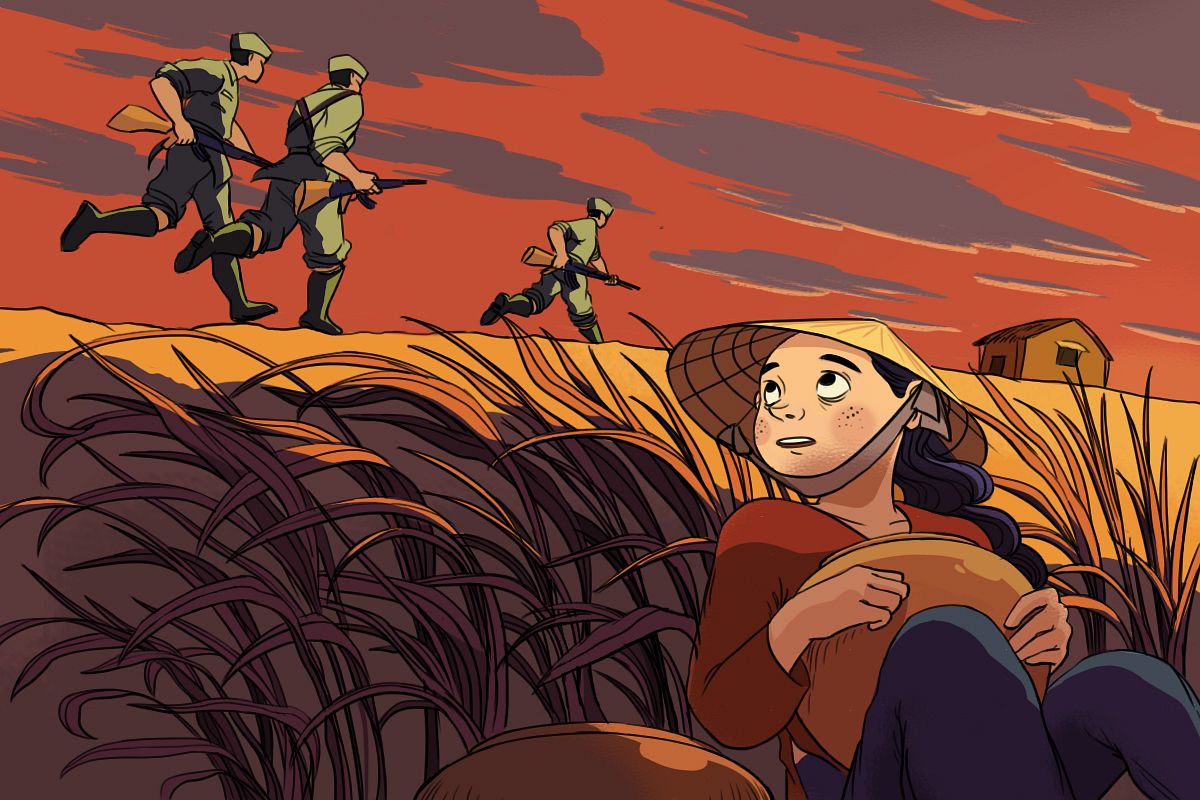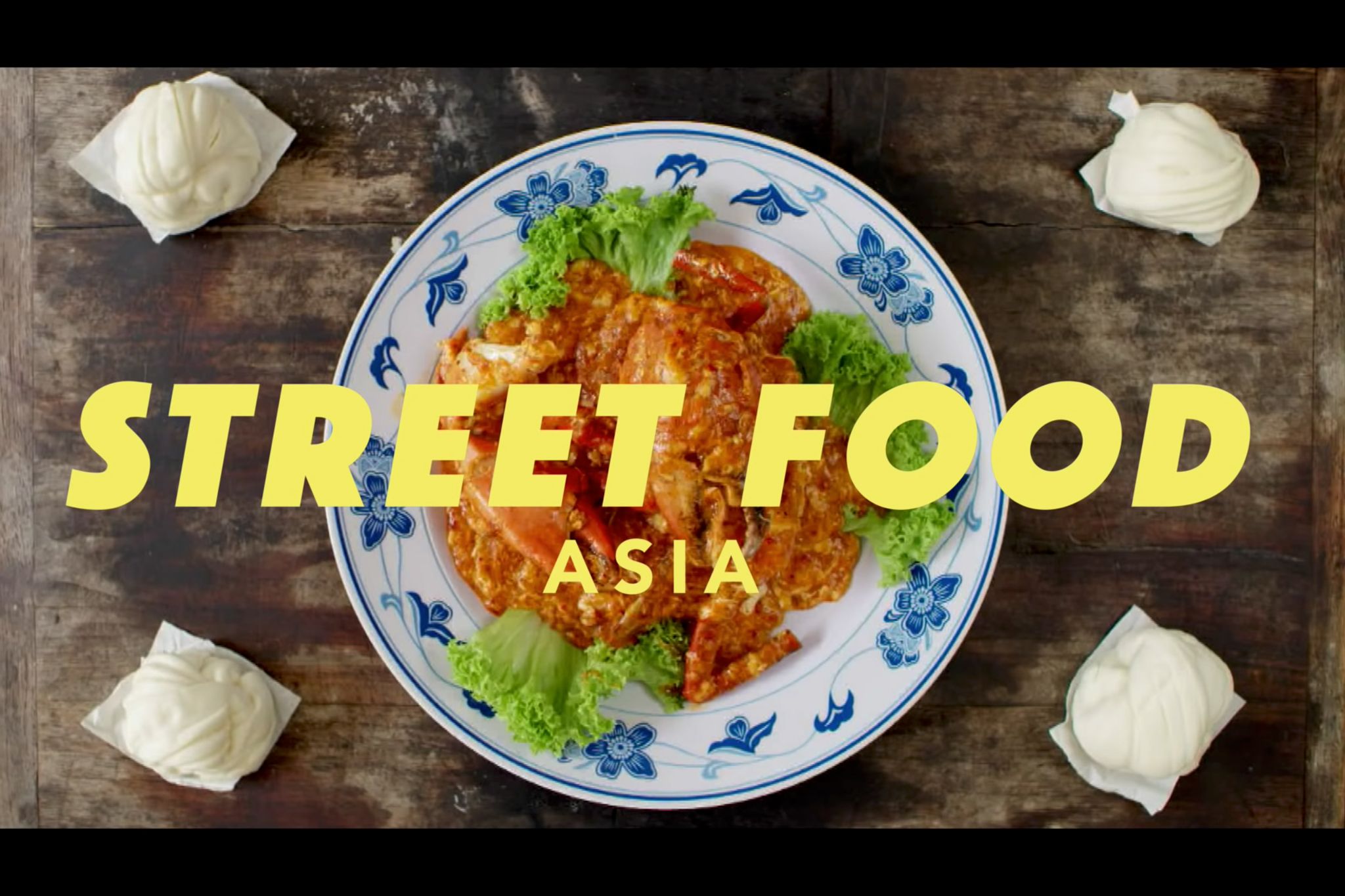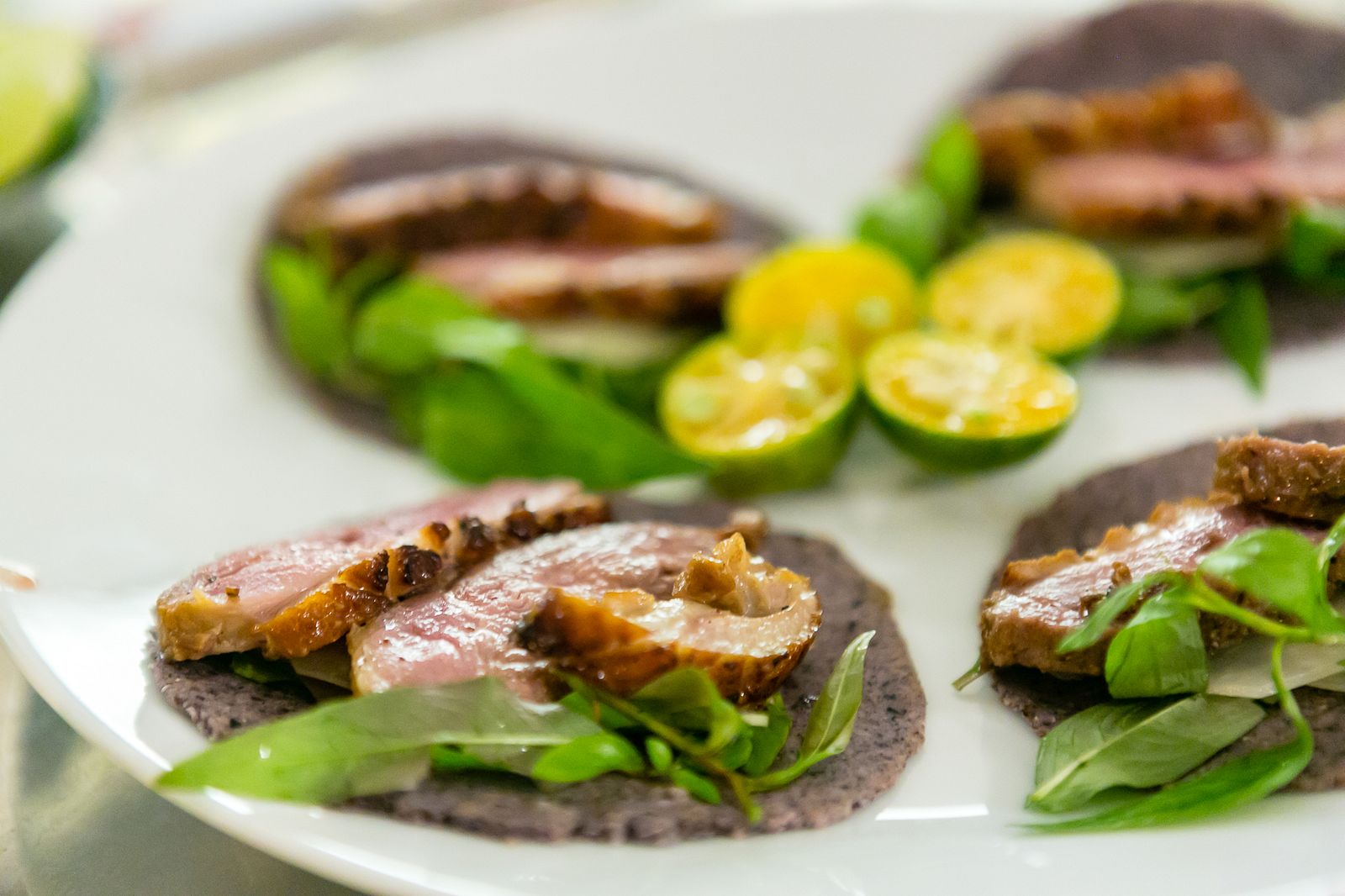Rose-tinted shades and long swept-back hair tickling the collar of a half-unbuttoned maroon shirt that revealed a dangling peace-sign pendant: at age 27, Minh was the epitome of 70s Saigon cool. More than that, though, he was one the most famous rice wine producers in Long An, a province renowned for its traditional liquor production. After Minh moved from the big city to his wife’s home village, her family discovered his natural talent and passed on their distilling knowledge which he spent decades perfecting.
Now at age 75, he still moves with a slick swagger but becomes dour when asked if we can buy some of his rice wine. Despite the “rượu nếp” sign prominently placed on the gates to his home, his stills have been dry for years. He cites competition from unscrupulous producers willing to cut their rice wine with chemicals, the threat of patrolling policeman and the inability to make any money from a population that is more interested in drinking beer as reasons for his retirement.

“Now, it’s a cheap coffee shop,” another man famous for making the beverage told us when we inquired where his rice wine pots and storefront were, giving the same explanations for why he abandoned a trade he’d been involved with for decades. He then expressed an emotion we encountered throughout our trip to Long An: he wasn’t especially sad to let it go. For him and many of the elderly rice winemakers in the town who had either already gone out of business or were nearing retirement age with no younger family members interested in carrying on the activity, they didn’t seem especially distraught. For them, it was merely a means for making money and there simply was no longer any profit in it.
Rice wine isn’t completely gone in Long An, however. Countless shops prominently displayed it for sale in hẻms, in fields and on the side of the busy highway, stored in one-, five- and ten-liter jugs typically used for storing gasoline. And nearly everyone we asked gave us the location of someone they knew who was making or selling it. On one occasion, when inquiring at a small stationery shop where we might find some, the owner pointed to her back room and explained that she had some there her parents made. But with all the operations run by people in their 60s and 70s who had been doing it since they were young, was such proliferation a sign of rice wine’s pervasive popularity or the last hurrah of a soon to be forgotten cultural art form?
From Colonial Oppression to Modern-Day Conglomerates
Before examining rice wine’s current position in Vietnam, we must continue where Part 1 left off. The violent and wildly ineffective monopoly that colonial France established in 1897 for production and sale to exact revenues from the colony and control native populations deteriorated even before Vietnam gained independence. In 1933, the license for the monopoly held by a French company was set to expire. An expanding public sphere and press at the time allowed liberal French and Vietnamese to speak out about the low quality alcohol that the monopoly’s industrial system produced as well economic feasibilities and social or political concerns. Unable to ignore realities, the government gave small, independent operations 31% control of the market and finally, by 1945, its stranglehold on the market had been dismantled.
Following the war with France and upon reunification, state-owned entities assumed control of liquor production. The factories and operations established by the French were absorbed by the Saigon Beverage Corporation, or Sabeco, alongside Habeco (Hanoi Beverage Corporation). Continuing in the tradition of the French monopoly’s industrial production methods, the rice wine they churn lacks the flavor and nuance that people pride homemade varieties on, to say nothing of the quality of ingredients. The desire to pump out massive batches at the lowest possible prices impacts not only taste but contributes to their reputation as hangover harbingers.
For these large companies which receive favorable tax incentives from the government, rice wine represents an insignificant percentage of annual profits compared to their flagship beers 333, Bia Saigon and Bia Hanoi. Moreover, both Sabeco and Habeco recently had large percentages of their stocks purchased by enormous international beverage conglomerates so there is no reason to think the ownership changes will usher in a shift to focus more on indigenous alcohols. Quite the opposite, actually: through marketing and promotion, it is likely they will continue trying to influence customers into drinking beer and other liquors.
Small Batch Production

Thanks to France’s inability to enforce their monopoly, during colonial rule many families in Vietnam continued to produce rice wine in their homes as they had for generations. While there have been some minor adjustments such as replacing ceramic jugs with plastic bins and bottles, and charcoal occasionally standing in for wood or rice husks, the process remains largely unchanged today. People buy local rice and boil it in huge pots, add a yeast pack that contains a myriad of ingredients and let it mature in the open air for three days before placing it in large containers for up to two weeks of fermentation. The spent rice is still sold to pig farmers in the area as feed.
Hoan Ny, a Long An women who invited us into her home to see her operation in process, explains that she makes about 20 liters a day and her most common customers are older locals who purchase it to make rượu thuốc — a type of rice wine that purports medicinal values thanks to the herbs and plants customers steep in it. She also fulfills orders of up to 100 liters of rice wine for weddings. In addition to selling directly to locals, small companies will often buy from numerous producers and bottle it under their brand name. In these cases, the rice wine is often sold in supermarkets and corner stores in larger cities.

A 2012 decree officially banned the sale and production of unregistered rice wine and requires all “investment, construction, food safety and quality, environment protection, fire and explosion prevention” at facilities to adhere to laws set by the Ministry of Industry and Trade. But while technically every producer should have a license and submit to official inspections, many ignore the rules because legacy and local familiarity hold much more sway than government papers when it comes to accountability and permission. “We’ve been making rice wine forever, we’re famous, so the police know us and we don’t have to worry,” Ny explained while also noting that if they were to test her product for purity it would pass with no problem.
The close relationship between producers and authorities seems endemic and it's easier to imagine an inspector stopping in to buy a bottle of rice wine and gossip with the producer than checking for official documents. So while authorities have been ramping up inspections, the crackdowns are mainly aimed at new producers and those operating outside the community in remote fields. Most traditional producers seem to appreciate the attempts to curtail duplicitous operations that sell cheap and dangerous products that serve as unfair competition and hurt the drink’s overall image.
An Image Issue
The average young person doesn’t drink much rice wine: it’s not served in extravagant glasses for members of the glitterati to sip on atop rooftop clubs accompanied by pulsing EDM music; bottles aren’t passed around amongst university students lounging at Turtle Lake; and it doesn’t appear on many menus at fusion restaurants catering to hipsters in District 1 and Thao Dien. It is largely considered a drink for old, especially rural, men.
Numerous factors have contributed to this perception. When Vietnam first opened to global markets in the 1990s, people understandably clamored to buy the new products flooding in; beer and alcohol were no exception. As the industry has further matured, an increasing amount of liquors, wines and craft beers have arrived, all marketed as hip and cool. In contrast, rice wine remains unmarketed and relegated to crude vessels in countryside homes.
Vietnamese laws exacerbate the new focus on beer. It is illegal to publicly advertise alcohol greater than 15% which means that, while one can see enormous Saigon Special billboards throughout the city and their commercials play during football broadcast halftimes, this will never happen for rice wine.
Rice wine’s portrayal as old-fashioned and distinctly uncool is far from a new phenomenon. When France was first establishing a colonial presence, their drinks became shorthand for wealth and modernity much like bicycles, tuxedos and gathering at Western clubs to dance the foxtrot. Vietnamese eager to embody a sense of modernity embraced foreign alcohol over rice wine. As one French customs official noted: “There does not exist a single indigenous official, no matter how minor or how insignificant his powers, who does not have at his home several bottles of ‘Cognac’, ‘Amaro’ or even of ‘Absinthe.’”
Legally-binding terms made clear distinctions between “indigenous/traditional and European/modern” beverages. Popular art and literature of the time underscored the divide. Stories by popular writers like Doan Phu depicted refined and mature characters engaging in Western lifestyles that included wine and champagne while bumbling and uncouth characters overindulged in rice wine. The theme also appeared in numerous comics and illustrations in the day’s newspaper.

Photo via ISSU.
At the turn of the 20th century, western influence was causing significant changes to Vietnamese society including altering the roles and expectations of women. Increased independence and involvement in a cosmopolitan social sphere involved consuming foreign alcohols. In Phu Nu Tan Van, the leading women’s magazine of the day, ads for Adet and Bisquit cognacs, Mana rum, De Jean liqueur, Quina Gentiane fortified wine, Hautes Côtes red wine, and Marquis de Bergey champagne appeared alongside those for clothes, makeup, perfume and cars. The publication further conflated foreign drinks with modern refinement through stories such as Nhat Linh’s story 'Doan Tuyet' in which women sip wine while discussing the trials of modern love. The effect was that even if drinking was becoming more acceptable for women, it wouldn’t be rice wine they’d reach for.
These perceptions of rice wine’s limited prestige persist today. As the nation modernizes and young people increasingly move to urban centers, not only do they lose connection with the agricultural foundations for rice wine production, but they also become exposed to and more able to afford foreign alcohols that they consider of higher status. Le Thanh Truc, a woman who set up a rice wine operation explains: “Vietnamese products are perceived as ‘boring, nothing new,’ and consumers are not assured of the quality.”
The name rice wine itself reveals its lack of global standing. Vodka, ouzo, soju, champagne and tequila: none of these are English words, and yet they’ve been readily adopted into the language, with people learning to correctly pronounce them or at least becoming comfortable enough to make an attempt. But on menus and in books, Vietnamese and foreigners alike decide to translate rượu to rice wine; a misnomer no less (it's a distilled spirit instead of wine). And while it would take some linguistic finesse — because rượu refers to alcohol in general and there are then numerous types — the same holds true for Japanese sake and foreigners have had no trouble developing a contextual meaning. The refusal to learn the Vietnamese word as people have for phở and bánh mì, underscores the outside world’s general unfamiliarity and/or indifference.
Death in a Bottle
In addition to not being en vogue, rice wine has earned a reputation as dangerous. Small batch production lacks oversight and producers or sellers eager to pad profits have been known to include dangerous additives such as pure methanol. Inexpert distilling can also result in unsafe levels of methanol in the final product.
Every year numerous stories emerge of people being hospitalized or even dying after consuming the poisonous rice wine. In 2011, for example, 60 guests at a wedding in An Giang had to be given medical attention and two died after being served. In the period around Tet last year when the drink is most widely consumed, two Hanoi residents died and 24 were hospitalized, leading authorities in the city to inspect 833 alcohol producers. Three out of 35 samples they tested in their lab contained excessive methanol content.
Traditionally, family, friends or neighbors in small communities produced the rice wine one would drink. Nearly all the rice wine producers in Long An that Saigoneer spoke with said the trust and familiarity they’ve earned are the keys to their success. As the population becomes more transient and less tied to agricultural lifestyles, however, drinkers are less likely to have a personal connection with the drink’s origin which leads to mistrust. With some notable exceptions, most of the rice wine production in Long An has moved out to the farmer fields with homes in town serving as nothing but storefronts. People buying it no longer can see the operation nor know the person making it which might dissuade them from purchasing it in favor of cheap beer.
The effects of the negative perception are quantifiable. In the past decade alone, rates of consumption and production of beer are exploding, while rice wine remains stagnant. Quang Long Commune in Quang Binh Province, for example, once had 100% of its households producing alcohol but the number has fallen to below 25% and relegated to only three or four villages.
Scales, Tails and Foreign Fetishization
Propaganda posters, animal feed bags repurposed as totes, tours of Con Dao Prison and the Cu Chi Tunnels, xích lô rides through District 1, and pseudo-retro cafes like Cong Caphe: modern-day Vietnam frequently repurposes aspects of its past to appeal to foreign tourists. Rice wine exemplifies this trend. Any visitor to Ben Thanh Market will undoubtedly notice the many large bottles of rice wine that contain snakes, scorpions and lizards aimed at visitors who want to return to their countries with a souvenir that captures an exaggerated exoticism of the country.

Known as rượu rắn, the animal-infused rice wine was not, however, invented for the sake of foreigners. As a subset of rượu thuốc, or medicinal rice wines, it has existed for centuries. Vietnamese associate the beverages made with snakes, lizards and birds with masculinity and virility. One person even reported a Saigonese acquaintance who has a jar of rice wine with a baby tiger inside for which he paid the equivalent of a new car. While there is, of course, no scientific truth to claims they contain any such powers, men continue to consume them with hopes of invigorated “potency.”
A study on rượu rắn reveals interesting specifics about its production. The Mekong Delta makes much of what is sold in the south thanks to its prevalence of wild snakes. Researchers discovered that drinkers prefer venomous species because they believe the venom enhances the drink’s purported medicinal quality, even though venom is denatured by alcohol. More than twenty species were observed submerged in the largely unbranded bottles including endangered cobras and pythons. The sellers and producers claim to get the snakes from markets and middlemen and thus do not know how they were obtained, yet one can reasonably assume that they are not gathered in a sustainable way nor one mindful of laws regarding animal trafficking. In this way, rice wine represents another example of Vietnam’s troubling track-record with species preservation.
Expat Presence
From restaurants to paintings to compiling Vietnamese music, foreigners have long involved themselves in the preservation and proliferation of various aspects of Vietnamese culture and it, therefore, comes as no surprise that several westerners produce and sell rice wine. Markus Madeja, for example, moved from his native Switzerland to Vietnam in 1993, and a fascination with traditional handicrafts brought him to Phu Loc in Hai Duong Province, a famous rice wine-producing village. He appreciated the drink and its surrounding culture but believed the process could be refined through modern production methods and greater quality control. What began with a couple dozen recipes produced in clay stills and served at a small highway restaurant with business partner Dan Dockery and wife Vu Thi Thoa, eventually grew into four locations and a custom-built distillation facility with modern German copper stills. The brand, Son Tinh, is available throughout the country.
When Madeja spoke with Saigoneer on the phone he brushed aside the idea that using new methods or European equipment somehow disrespects the craft. It’s always been evolving to match tastes, technologies and standards he explained; it’s just today we have the ability to speed up the pace of that evolution. Likening it to the fact that people no longer wear hemp clothing, he said producers traditionally employed whatever modern methods were at their disposal to make the best rice wine they could, so it should be no different now. The changes ushered in extend to how it’s served, and in addition to eschewing shot glasses for bulb-shape sifter like vessels, his bars serve a variety of cocktails that incorporate the liquor.
Informed by his background in anthropology, a desire to preserve a unique aspect of Vietnam’s culture helps motivate Madeja’s work. He expressed dismay that young people seem largely uninterested in drinking or making it because its survival depends on people passing it down generation to generation; once that chain is broken, crucial knowledge is lost forever. He noted that rice wine needs to be branded and marketed in a way that competes with trendy alternatives. If Vietnamese drinkers value it, they’ll pay more attention to it which will lead to greater quality and a necessary cycle will begin.
Another foreigner looking to spread awareness of rice wine is French-Canadian Maxime of Drink Vietnam - The Nguyen Shack Little Museum of Herbal Spirits and Tea. The large lobby of his District 1 hostel contains shelf upon shelf of more than a hundred different kinds of rice wine made with everything from mangosteen and sapodilla to pennywort and wormwood available to taste and purchase. He discovered rice wine via the traditional medicine he sought for a mystery illness. After recovering, he became increasingly interested in the field and eventually came to rượu thuốc, the version of the spirit made with herbs and other ingredients believed to have healing properties.
Godin-Murphy wanted to share his fascination for traditional curative herbs with young people and foreigners, but because he isn’t a doctor, he had to “give it a twist and focus on the good flavor that we can find in these special herbs,” he told Saigoneer via email. Coincidently, his wife, Nguyen Thi Theu, hails from Kim Son in Ninh Binh Province, a renown site of generations of rice wine distillers. Her sister-in-law makes a sticky rice version and ships it to Saigon where he adds the ingredients, including some original flavor concoctions.

The role of expats in preserving Vietnamese culture invites complex ruminations. Histories of appropriation and colonial exploitation should warrant a certain degree of suspicion. Independent of those concerns, it’s clear that foreigners and Vieu Kieu often receive a greater amount of press attention for their activities, deserved or not. On the other hand, if one considers heritage artifacts like rice wine worthy of preservation, anyone willing to work towards conservation, especially without obvious economic incentive, should be welcomed.
A Lost Cause?
Honored guests to a French home will likely be offered a glass of wine; visitors in Scotland will be given a dram of whisky; and an American host will probably pour a snifter of bourbon or craft beer; but here in Vietnam, one is more likely to open a bottle of Hennessy or Johnny Walker than pop the cork on a jar of rượu to celebrate a special occasion. Should we lament such a situation and condemn racist and colonizing causes for the situation while actively and individually attempting to change the trend by supporting the industry?
While rice wine production persists and people, especially in rural areas, will continue to drink it for the foreseeable future, anecdotal and scientific evidence suggest it’s on the decline. As the country continues to urbanize and city dwellers show little interest, it’s hard to be optimistic about its future. While there are certain Saigon restaurants that include it on their menu, they stick out as exceptions. Perhaps the work of dedicated foreigners and young Vietnamese will use their marketing skills to resuscitate the trade and entice new generations of drinkers, but it’s easy to imagine a Vietnam with even less rice wine.
Maybe we should ask ourselves whether, ultimately, we care if the production and appreciation of rice wine disappears. Is every element of a culture important even if it contributes to road accidents, violence and moral ills? Perhaps not if rice wine was disappearing for the sake of sobriety, but that certainly isn’t the case. Given such a reality, shouldn’t we view rice wine the same way as we view the loss of an endangered species because as Ho Chi Minh himself lamented while in prison, what good is life “without alcohol, without flowers?”

This is the end of part 2 of our series on the history of rice wine production and consumption in Vietnam. Read part 1 of the series here.















